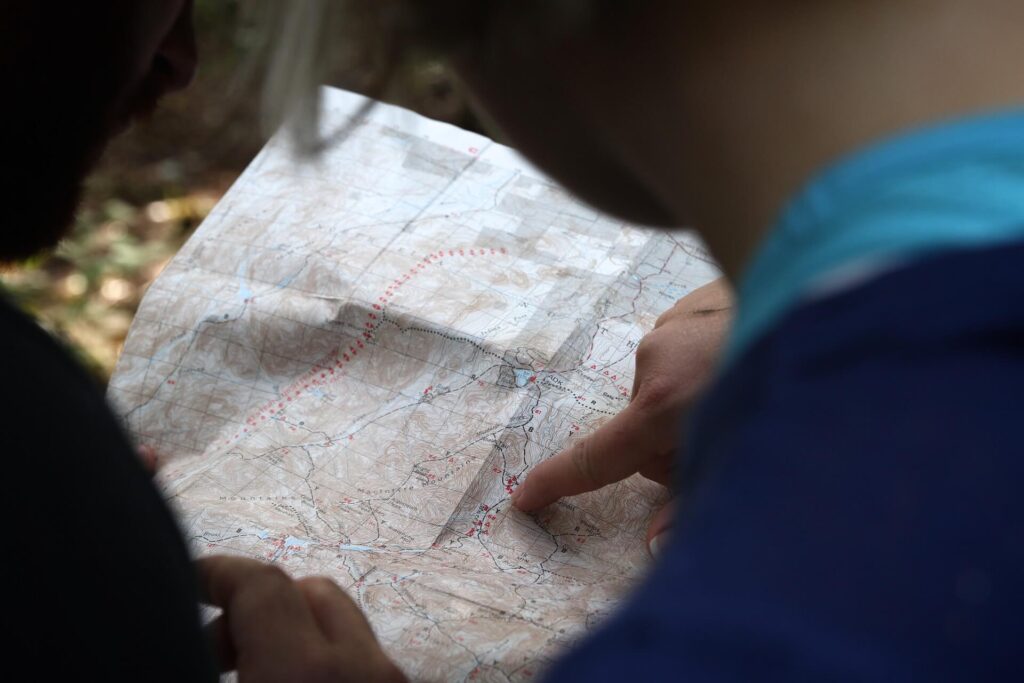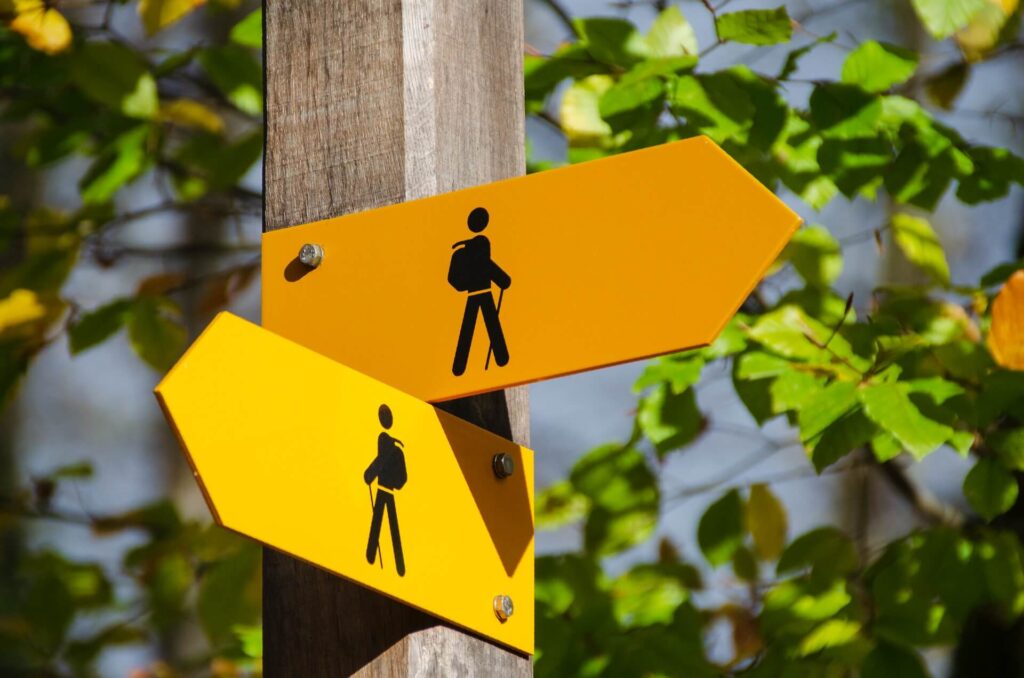Updated on January 28, 2024 by Lou Mac
Learning how to ask for directions in Spanish is key to a smooth trip.
You can try to rely on Google Translate, but there’s the very real possibility that you will find yourself without battery or signal (this happened to me!).
Plus, it’s just nice to interact with locals when you’re travelling, and don’t you want to put your new Spanish skills to the test?
In this post I’ll share everything you need to know about directions in Spanish, starting from how to approach people and understand their responses, right through to cultural considerations and an example interaction.
How to Approach People in Spanish
First things first: How to approach someone and (politely) get their attention. We wouldn’t just go up to someone in English and say “Tell me how to get to the train station,” we’d throw in a few “Excuse me’s” or at least say “Hello” or some other greeting first!
- Hola – Hello
- Buenos días – Good morning
- Buenas tardes – Good afternoon
- Buenas noches – Good evening/night
- Disculpe – Excuse me
- Perdón – Sorry
- Perdone – Sorry
- Señor / Señora – Sir / Ma’am
- Estoy perdido/a – I’m lost
- ¿Me podría ayudar? – Could you help me?
Example sentences:
Disculpe, ¿dónde está el museo? (Excuse me, where is the museum?)
Buenos días señora, ¿sabe dónde está el baño público? (Good morning ma’am, do you know where the public bathroom is?)
Perdón, ¿hay un banco por aquí? (Sorry, is there a bank around here?)
Hola, estoy perdida. ¿Me podría ayudar? (Hi, I’m lost. Could you help me?)

How to Ask for Directions in Spanish
Once we’ve successfully segued into our conversation with a stranger, it’s time to actually ask for directions. Make sure you study these phrases well – sometimes it’s harder to understand people’s responses than to actually ask the questions! (Especially if you’re travelling in Chile 😅)
- ¿Cómo llego a…? – How do I get to…?
- ¿Cómo puedo llegar a…? – How can I get to…?
- ¿Me puedes indicar el camino a…? – Can you show me the way to…?
- ¿Cuál es la mejor forma de ir a…? – What is the best way of getting to…?
- ¿Cómo regreso a…? – How do I get back to…?
Example sentences:
¿Cómo llego al museo? (How do I get to the museum?)
¿Cómo puedo llegar al centro? (How can I get to the centre?)
¿Cuál es la mejor forma de ir al parque nacional? (What’s the best way of getting to the national park?)
If you just want to know where something is and not necessarily get the directions, the following phrases are for you (though they are also indirect ways of asking for the directions!)
If you’re not super confident with your Spanish, the easiest way to do this is just to say the place you’re looking for but put a rising inflection (when the pitch of your voice goes up) on the end. This will turn it from a statement to a question!
For example:
Disculpa, ¿el museo? (Excuse me, the museum?)
Señor, ¿el baño público? (Sir, the public bathroom?)
Perdone, ¿el banco? (Sorry, the bank?)
Now here’s a list of common words and phrases to ask where something is in Spanish:
- ¿Dónde está/están…? – Where is/are…?
- ¿Sabe dónde…? – Do you know where…?
- ¿Dónde queda…? Where is… located?
- ¿Dónde puedo encontrar…? – Where can I find…?
- Busco/estoy buscando… – I’m looking for…
- ¿Hay… cerca de aquí? – Is there… near here?
- ¿Está cerca/lejos de aquí? – Is it near/far from here?
- ¿Qué tan lejos está…? – How far is the…?
- ¿Cuánto tiempo se tarda en llegar a…? – How long does it take to get to…?
Example sentences:
¿Dónde puedo encontrar el metro? (Where can I find the metro?)
¿Dónde queda el restaurante? (Where is the restaurant located?)
Estoy buscando el mercado de navidad (I’m looking for the Christmas market)
¿Hay un terminal de buses cerca de aquí? (Is there a bus terminal near here?)
¿Qué tan lejos está la biblioteca nacional? (How far is the national library?)
Understanding Directions in Spanish
As I mentioned earlier, asking for directions is one thing, but understanding them is another!
I remember when I plucked up the courage to ask for directions from a shopkeeper in Buenos Aires. I could understand everything he said, but for one key term: cuadra. In the end, he had to leave his store to point out the way for me 🥲
So: make sure you learn some related vocabulary so that you can follow directions people give you! (Oh, and cuadra means “block”!).
Fundamental Direction Terms
- Izquierda – Left
- Derecha – Right
- Derecho – Straight
- Adelante – Ahead
- Cerca – Close
- Lejos – Far
- Al lado – Next to
- El otro lado – The other side
- En frente – In front
- Adentro – Inside
- Afuera – Outside
- Desde – From
- Hasta – Until
- Norte – North
- Sur – South
- Este – East
- Oeste – West
Common Verbs Used with Directions
- Ir – To go
- Caminar – To walk
- Parar – To stop
- Llegar – To arrive
- Girar – To turn
- Seguir – To follow
- Cruzar – To cross
- Pasar por – To pass by
- Subir – To go up
- Bajar – To go down
- Entrar – To enter
- Tomar – To take
- Venir – To come
Transportation Words
- La calle – Street
- El camino – Path/way
- La cuadra – Block
- La esquina – Corner
- El semáforo – Traffic light
- La entrada – Entrance
- La salida – Exit
- El auto/carro/coche – Car
- El autobús – Bus
- El tren – Train
- El metro – Metro/Subway
- El taxi – Taxi
- El avión – Plane
- La bicicleta – Bicycle
- La parada – Stop
- La estación – Station
- El terminal – Terminal
- El aeropuerto – Airport

Tips to Help You with Directions in Spanish
We’re almost there! We’ve got the basics down, but there are a few more things that are useful to know.
What to Say if You Don’t Understand
If someone uses words you don’t understand or they speak too fast, don’t be embarrassed! You can just politely ask them to repeat themselves, or even write the directions down.
- No entiendo – I don’t understand
- ¿Puede hablar más despacio? – Can you speak more slowly?
- ¿Puede repetirlo, por favor? – Can you repeat that, please?
- ¿Puede escribirlo? – Can you write it down?
- ¿Puede usar palabras más simples? – Can you use simpler words?
- ¿Hay alguien que hable inglés? – Is there someone who speaks English?
- ¿Puede hablar más fuerte? – Can you speak louder?
Formal vs Informal Language
You may know that in Spanish you can either address people formally or informally. The choice between these forms of address reflects the level of familiarity and respect in the conversation.
So if you’re asking a stranger for directions, make sure you use the formal usted (and related conjugations) instead of tú! In this post I’ve only used the usted form, just to be on the safe side. Of course, if you’re asking family or friends for directions, you can use tú forms.
You can read more about formal vs informal Spanish here.
Cultural Considerations
Asking for directions in Spanish extends beyond linguistic nuances: Cultural considerations play a crucial role in fostering effective communication.
For example, it’s polite in most Spanish-speaking countries to greet people before asking for directions. So like we talked about at the beginning of the post, you should initiate the conversation politely, ideally with a greeting, before jumping into your request. And make sure you end with a big muchas gracias (thanks a lot) as well!
You should also be aware that in some Spanish-speaking countries (like in lots of other countries around the world) it’s not very common to be approached by strangers. So don’t be offended if someone ignores you or is weary of talking to you.
Example Interaction of Asking for Directions in Spanish
A) Hola, disculpe, ¿usted es de aquí? (Hello, excuse me, are you from here?)
B) Hola, sí, soy de aquí. (Hello, yes, I’m from here.)
A) Estoy un poco perdida. (I’m a bit lost.)
B) Mmm. ¿Dónde quiere ir? (Mmm. Where do you want to go?)
A) Estoy buscando el terminal de bus, ¿sabe dónde está? (I’m looking for the bus terminal, do you know where it is?)
B) Sí, sé dónde está. Pero, está un poco lejos desde aquí. Está en el otro lado de la ciudad. (Yes, I know where it is. But it’s a bit far from here. It’s on the other side of the city.)
A) Qué molesto… ¿Sabe si puedo llegar allá en metro? (How annoying. Do you know if I can get there by metro?)
B) Mmm, creo que es muy tarde para el metro, pero quizás puedes tomar un bus o un Uber. (Mmm, I think it is too late for the train, but maybe you can take a bus or an Uber.)
A) Un Uber sería mejor. ¿Cómo se llama el terminal? (An Uber would be better. What is the name of the terminal?)
B) Depende a dónde vas. (That depends where you’re going.)
A) Voy a Concepción. (I’m going to Concepcion (a city in Chile).)
B) Entonces tienes que ir al Terminal Sur. (Then you have to go to the South Terminal.)
A) Muy bien, muchas gracias. ¡Lo voy a buscar ahora! (Oh great, thank you very much. I’ll look for it now.)
Now you’re equipped with all the direction-related words you need for your adventures!
Remember to have fun with it, and take it as an opportunity to chat to some locals.
¡Buen viaje! (Have a good trip!)

